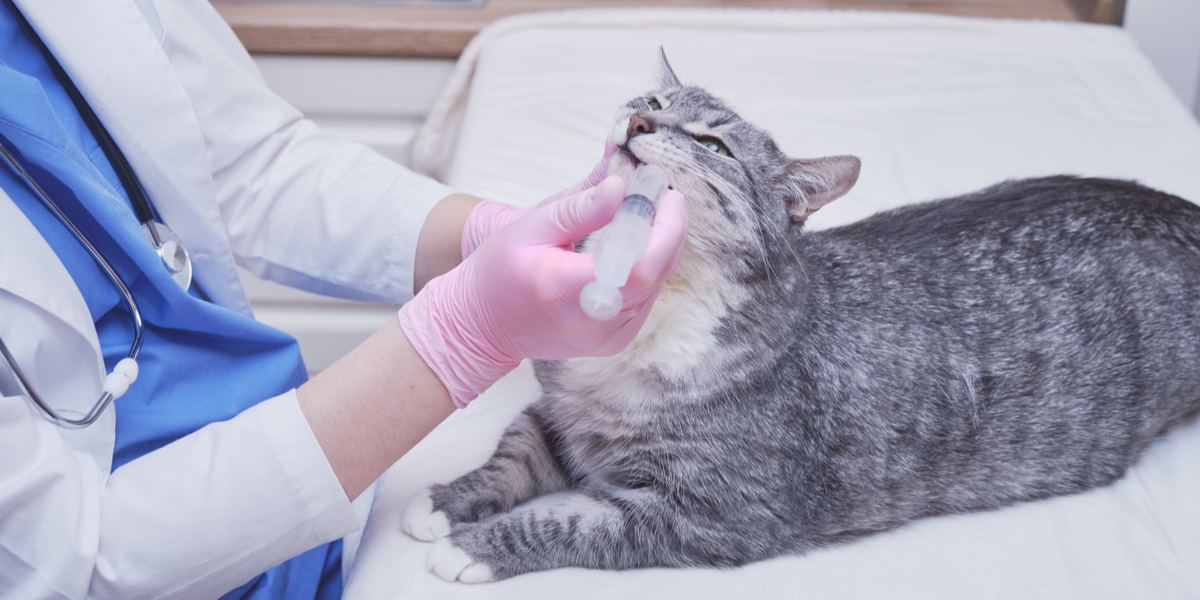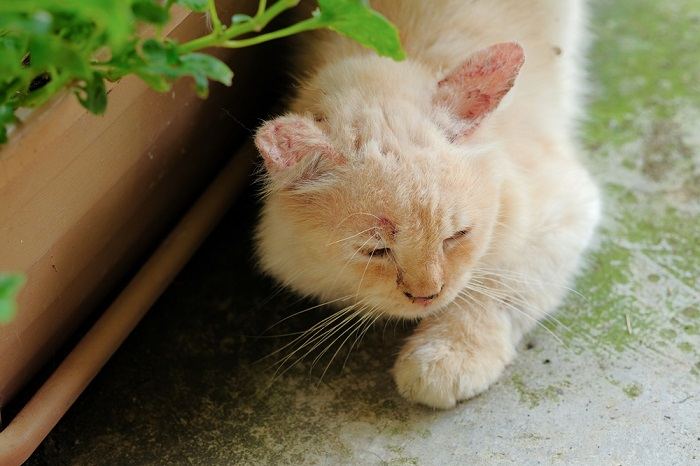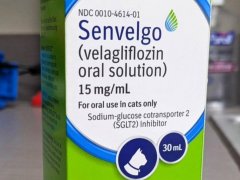
Itraconazole is an oral antifungal medication used in cats to primarily treat the fungal infection known as ringworm. In this article, you will learn what itraconazole is, how it works, the types of fungal infections it targets, side effects to look out for, and some frequently asked questions.
Itraconazole for Cats Overview

About Itraconazole for Cats
Itraconazole is classified as a fungistatic triazole compound. It works by inhibiting an enzyme that produces part of the fungal cell wall, thereby severely weakening susceptible fungi.
Itraconazole has activity against several types of fungi, including yeasts and dermatophytes, the latter being the causative agents of ringworm of which Microsporum canis is the primary concern in cats. Additional fungi it has efficacy against include Candida spp, Aspergillus, spp, Cryptococcus spp, Histoplasma spp, and Blastomyces spp.
The veterinary product Itrafungol is an oral solution of itraconazole that is labeled for use in cats. Sporonox is a human brand that is also sometimes used.
Also Read: Fungal Infections In Cats: Causes, Symptoms, & Treatment
What Itraconazole Does for Cats
Itraconazole is FDA-approved for use to treat ringworm, or dermatophytosis, in cats. It is caused by Microsporum canis. There are a few species of dermatophyte fungi that can cause ringworm, but Microsporum canis is the most common and principal causative agent in cats. Microsporum canis causes a form of ringworm that is transmissible to both dogs and to humans.
Contrary to its misleading name, ringworm is caused by a fungus. Its common appearance may show up as single or multiple areas of hair loss and crusting on a cat’s skin. It can often be found most especially on the areas of the head, face, and ears. This is because inquisitive cats often pick the fungus up when checking out dark moist locations where it tends to exist naturally. The fungal spores can thrive on surfaces for 12 to 18 months.
Ringworm can also be transmitted through direct contact with another cat or other animal that is currently infected. In cats, especially longhaired ones, a carrier state may also exist and infect other animals or people through contact. This can happen even though no skin lesions or hair loss is visible.
In some cases where single lesions are found, it is common to use a topical cream or lotion containing an antifungal agent.
If multiple lesions are present or if there is concern that a cat may be a carrier, more comprehensive therapy is employed. Itraconazole is one of these therapy options. Other therapy measures include continued use of topical treatments, bathing with antifungal shampoo, or a product called lime sulfur dip.
Treatment of ringworm in cats is typically successful. It still often requires treatment for several weeks to a couple of months.
While an off-label use, itraconazole may also be used for skin infections involving Malassezia yeast fungi that cause skin dermatitis and infections.
There are some less common types of fungal infections in cats that itraconazole may also be used for in an off-label manner. This includes aspergillosis, cryptococcosis, coccidioidomycosis, sporotrichosis, blastomycosis, and histoplasmosis.
Also Read: How To Bathe A Cat? (A Step By Step Guide)
Side Effects of Itraconazole for Cats

Ringworm is a fungus that shows up as lesions on a cat’s skin and can be treated with antifungal medication, such as itraconazole.
In cats, the most common adverse effects of itraconazole use include predominantly gastrointestinal effects like decreased appetite, vomiting, diarrhea, increased drooling, and weight loss.
Itraconazole’s side effects in cats appear to be dose-dependent. At higher doses, GI side effects may be more likely and severe, and signs of liver toxicity have been reported more often. Cats on higher doses were found to have liver concerns about 30% of the time.
It is common to check liver values while using itraconazole, especially if any signs of a digestive upset have occurred. Because effects are considered dose-dependent, the medication may be discontinued until liver values have returned to normal. It can then be restarted at a lower or less- frequent dose.
Also Read: Gastroenteritis In Cats: Causes, Symptoms, & Treatment
Dosage of Itraconazole for Cats
The FDA-approved, labeled dosage for itraconazole (Itrafungol) for cats to treat Microsporum canis is 5 milligrams/kilogram by mouth given once daily for seven days on alternating weeks, This lasts for three treatment cycles.
The veterinary-labeled oral solution Itrafungol can be given with or without food. The human-labeled oral solution (Sporanox) is typically advised to be given without food to aid in better absorption.
How Long a Cat Should Take Itraconazole
Cats are essentially treated on weeks one, three, and five, and left untreated on weeks two and four.
Both of the FDA-approved brands, Itrafungol (approved for cats) and Sporanox (approved for people), appear to have high bioavailability in cats. The human capsules are not absorbed as well in cats and their dosage size will far exceed the needed dose for most cats, making liquid forms more practical and effective.
Also Read: How To Give Your Cat A Pill (With 7 Proven Tips!)
In general, if ringworm is found on one cat in a household of multiple cats, all cats should receive administration of itraconazole treatment together at the same time. An asymptomatic carrier state in one of the cats is always possible. Treating just one cat can result in a ringworm infection not resolving as expected or being reacquired.
Doses for other types of fungal infections can depend greatly on what organism is present and should be up to a veterinarian’s discretion.
Because ringworm can resemble lots of other skin conditions that are not caused by Microsporum canis, it is very important to always have a diagnosis based on testing by a veterinarian before starting itraconazole.
Fungal infections can take a long time to treat, often requiring several weeks of medication. It is very important to always continue treatment as directed. This is true, even if visible hair loss or other lesions on your cat’s skin and fur appear to have resolved. Continuing treatment at least one month beyond a negative ringworm culture or PCR is the general standard.
Also Read: Common Skin Problems In Cats: Causes and Treatments
Compounded Itraconazole for Cats

Compounded itraconazole should not be used to treat cats with ringworm as it has been found to be less effective than the FDA-approved brands.
Compounding medications are very common in veterinary medicine. This is because it allows us to provide medical therapy for our animal patients by different dosage routes. It also makes dosing easier based on the form of a medication or its flavor.
However, in the case of itraconazole specifically, it is recommended to not use a compounded form. Studies have shown that these forms are far less bioavailable and less effective than FDA-approved brands.
Itrafungol, the FDA-approved brand for cats, also comes with a dosing syringe. The syringe allows for the most accurate dosing in cats. This is important, given the higher risk of side effects with inappropriate doses.
Also Read: Why Is My Cat Not Eating?
Conclusion
Itraconazole is a common antifungal medication used in cats. It is used predominantly to treat cats with ringworm fungal infections that have multiple lesions or a carrier state. Although GI and liver effects can occur, they appear to be very dose-dependent in cats. The FDA-approved brand Itrafungol is recommended for the best efficacy and safety.
Drug Dosing Disclaimer: We are only able to provide doses for medications that are FDA approved for use in cats and only as the label guidelines dictate. For medications that are used off-label we can only provide guidelines and safety information for use. Safe and appropriate dosing for off-label medications can only be determined by a primary care veterinarian.
We encourage you to work with your veterinarian to determine if a particular medication is appropriate for your cat. Changing or adjusting a dose for your cat on your own without consulting with a veterinarian can carry risk. We do not encourage use of medications prescribed for human use in pets without first consulting with a primary care veterinarian.
Frequently Asked Questions
What does itraconazole treat in cats?
Itraconazole is labeled for use in treating the ringworm/dermatophyte fungus Microsporum canis in cats. The brand Itrafungol is FDA approved for this use in cats. Off-label, itraconazole can be effective in treating a variety of other fungal infections caused by other fungal organisms.
How long does itraconazole take to work in cats?
The FDA-approved brands are highly bioavailable in cats but because the drug has a long half-life, it may not reach appropriate concentrations for up to one week.
For ringworm, most people will see noticeable improvement or even resolution of hair loss, crusting, or other signs after the first month of treatment. However, it is always important to base further treatment on repeat testing to ensure treatment is not discontinued too early, which could lead to recurrence.
Is itraconazole safe for cats?
The brand Itrafungol, which is FDA-approved for cats, appears to be well-tolerated at the appropriate doses. This brand includes a dosing syringe for accurate dosing. Side effects and toxicity of itraconazole appear in cats to be very dose-dependent, highlighting the importance of proper dosing under a veterinarian.
If side effects are seen, it may be possible to discontinue the drug temporarily and restart it at a lower dose or frequency.
How do you give a cat itraconazole?
The most effective dosage form for cats is one of the FDA-approved liquid solutions. Capsule forms are much less bioavailable in cats, and compounded forms of the medication have also proved to be less effective from decreased absorption.
The liquid solution approved for cats can be given with or without food, meaning that it could be given directly by mouth using the included syringe, or potentially directly on food if a cat will eat it shortly after.
It has been noted that the FDA-approved human brand Sporanox is better given without food, meaning this solution form is best given directly by mouth at least one hour before or after a meal, for best absorption.








My cat is taking this drug because he has Valley fever. I find the most common side effect is that my cat appears to be in what I call La La land very docile, sleeps a lot. He appears to be confused, he looks at his litter box and then urinates on the small carpet in front of this box. He is only eight years old and never did this before.
Hi Liam, I’m sorry to hear about the Valley Fever, it is a difficult disease to treat and takes a long time. Depression is a less common side effect but it has been seen. Side effects with itraconazole tend to be dose dependent. Given the length of time that Valley Fever must be treated, it’s important to mitigate any side effects that are significantly affecting quality of life. Options are reducing the dosage if appropriate or changing medications (such as to fluconazole for example). Itraconazole is typically given as a liquid to cats. That does make dosage adjustments easier. It’s important to talke to your vet about the effects your seeing and the next best step. It’s also important to check labwork periodically because of the effects itraconazole can have on the liver and it’s important to rule out side effects coming from adverse effects on the liver.
Daughter brought kitten home next day discovered spots – took to shelter and they started antifungal with all other precautions – her adult cat is 2 and healthy, should he be started on antifungals without Petre Dish confirmation? They used iodine on spots – for 5 days – dipped in Lyme SULPHUR dip 1x and plan on using spot dip treatment plus antifungal on the kitten- is this appropriate for both kitten and adult cat
Hi Debbie,
This can be an approach with the lime sulfur dip though it often has to be repeated more than just one time. The spots do have to continue to be treated. Sometimes with just one or two isolated spots, topical approach can be okay. But with multiple ones, you’d have to do full dips or a systemic antifungal like itraconazole. Whether you treat the adult cat in the home may depend on whether or not they had any contact. I couldn’t tell if any contact between them had occurred. Cats can be asymptomatic carriers and they can maintain the fungal organism in the coat, especially if it’s a long-haired coat. I have seen cats share ringworm back and forth, so it is usually my own preference to treat any cats in the home together at the same time. Another approach could be doing the PCR testing on the adult cat. PCR testing as a way of detecting ringworm is much more sensitive and accurate than plating on media and results come back in a ridiculously shorter period of time (a couple days). The kitten should have testing done at the end of the treatment course as well, at least a month past the resolution of any visible lesions. Another cause of small hair loss spots can also be mange (either demodectic or sarcoptic) though this is much less common in the last 10 years or so.
kucing saya jamuran dan bulu-bulunya rontok pada area yang berjamur. usianya kurang lebih 1-2 bln. bolehkan dibarikan obat itraconazol? dan berapa dosinya?
[Translated from Indonesian with Google Translate]: My cat has fungus and his fur is falling out in the moldy area.
approximately 1-2 months old. can I give itraconazole? And how much is the dose?
Hi,
I cannot recommend if itraconazole is the right thing to use, because I cannot be certain if your cat has the ringworm fungus for sure. The labeled dose for itraconazole in the US is 5 milligrams per kilogram for the brand Itrafungol. It is given once a day for one week, then the next week is taken off. This cycle is done a total of 3 times. It would be best if a veterinarian helps to diagnose ringworm for certain and then prescribe the right dose based on your cat’s current weight.
If there is only one area that is affected, you may also consider 1% miconazole lotion as well as 1% terbinafine cream (the brand Lamisil).
[Translated back to Indonesian with Google Translate]:Hai,
Saya tidak dapat merekomendasikan apakah itraconazole adalah obat yang tepat untuk digunakan, karena saya tidak dapat memastikan apakah kucing Anda pasti terkena jamur kurap. Dosis itrakonazol yang tertera pada label di AS adalah 5 miligram per kilogram untuk merek Itrafungol. Diberikan satu kali sehari selama satu minggu, kemudian minggu berikutnya diliburkan. Siklus ini dilakukan sebanyak 3 kali. Sebaiknya dokter hewan membantu mendiagnosis kurap secara pasti dan kemudian meresepkan dosis yang tepat berdasarkan berat badan kucing Anda saat ini.
Jika hanya ada satu area yang terkena, Anda juga dapat mempertimbangkan larutan mikonazol 1% dan krim terbinafine 1% (merek Lamisil).
My cat has fungal infection since we r adopted and now we have started her treatment from last month but no good results r seen so can i give itraconazole to her
Hi Nida, I’m not clear what type of fungal infection your cat may have or if a fungal infection has been confirmed here. It sounds like you may have been using another medication to treat this issue that is not working? The best advice here is to have your veterinarian assess what you’re seeing to determine if a fungal infection is really present and what type (fungal yeast vs. ringworm, etc.). Itraconazole is used often for ringworm in cats, but it shouldn’t be used unless that is confirmed and prescribed specifically for a cat by a vet.
Can it be assumed that while a cat is on oral Itraconazole, it cannot contract ringworm?
We have two cats – one came to us with the infection which we did not know so treatment was delayed. When asked to prophylactically treat the other cat we were told no. The second cat did end up with the infection as well and is now on meds. Both have been responding very well and cleaning has been upheld regularly. Can we let them finally start spending time together if they’re both on oral treatment and visibly healing? I understand the ultimate answer would be waiting for cultures but logically, they should not be able to reinfect each other while on meds, no?
Thanks.
Hi Rae,
I have certainly taken the approach of treating all cats in the home when one has ringworm in order to prevent others from developing lesions, since ringworm can be very contagious. The decision to do that can depend on how many cats are in the home and the general health of the other cats.
If there are only two cats in the home and both are on itraconazole, there is no reason I see why they can’t spend time together as normal. I at least have not seen the need to have two cats both on the same treatment schedule to be kept separate. They would still be subject to the same recheck parameters of negative culture, etc. at the same times.
My cat luca was diagnosed w ringworm with lab testing he still had positive results after two rounds of itranocol . He is a long haired cat and i have read they can have positive results without active infection because of that . it was referred to as dustmops. He had only one visible lesion under ear which has healed and there are no other pets-in home. The lab does not specify number of spores so i cannot tell if amount is decreasing .shouldn’t lab give that information? I have been told to give him a third round of med but i am concerned since he is a senior cat. Is there a topical treatment that can be used on face that safe? He also had alot if wax discharge in ear and some redness caused him to shake his head . We tested for infection that was negative .tried synotic drops for inflammation but the steriod in them made him aggressive.My poor cat has been through so much with this i just want him well . Please any input will be very appreciated . The information you posted was very informative, thankyou
Hi Pat,
Ringworm in cats can be very frustrating to be sure. The standard for treating a cat with ringworm lesions is to ensure two negative sequential fungal cultures.
Unfortunately, most labs don’t provide quantitative results in terms of spore colony numbers. This is really just an option for some vet offices that may plate their own ringworm cultures.
So while cultures are a standard recheck method, they have to be interpreted in the right context.
A “dust mop” cat, usually with long hair, has managed to snag some fungal spores from the environment that are lingering in the hair but there are no lesions on the skin, hair loss, etc.
There is some strategy that can be used. Microsporum canis is the species of ringworm we care about the most because it causes outbreaks and is most transmissible to people.
If we know it originally grew in a culture, its presence can be rechecked with a Wood’s lamp. Over 90% of M. canis will fluoresce if it’s infected hair shafts. If it does not, active infection is likely not present.
If a culture is still positive, it may be picking up spores in the coat, especially if the collection method was running a toothbrush through the fur.
In these cats, it is a common recommendation, if spores are confirmed in the coat but the cat has no lesions, to do a lime sulfur bath, which kills the spores on the coat.
OTC 1% terbinafine (Lamisil AT) can be useful for solitary lesions but itraconazole is the treatment choice for cats in many cases.